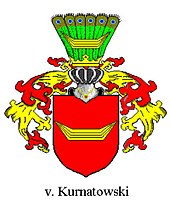Kurnatowski
Kurnatowski is the name of an ancient Polish nobility . It appears for the first time in 1386 with Nicolaus Starogrodzki on Bytyń (Prussian Birnbaum District ). The name comes from the Kunratowice estate , documented in 1448 in the family property. Originally the name was therefore Kunratowski; the form of the name Kurnatowski only became established in the 16th century. Belonging to the ancient Polish nobility results from belonging to the Łodzia family of arms. With the coat of arms name and the nickname due to the earliest important possessions, the full family name is originally Łodzia z Bytynia Kurnatowski in Polish. Since the 15th century, the surnames in Polish, which until then changed hands, have been retained or even inherited as the main family name. The last documented bearer of the name with the spelling Kunratowski is Świętosław Łodzia z Bytynia-Kunratowski, who appeared as the owner of the Kunratowice estate before the Poznań Castle Court.
The Kurnatowskis were politicians, artists, the military, Calvinist clergy and chamberlaughters. They owned extensive land, but it was confiscated during World War II , and especially afterwards.
The family was divided into three lines in the 17th century (Kurnatowice - this includes the Lithuanian branch -, Wola and Pożarowo). The partitions of Poland in 1772, 1793 and 1795 made part of the family Prussian. This was counted in Prussia to the local nobility. From around 1864 part of the family formed a Russian branch, which was recognized there as aristocratic. It confirms that the noble dignity of the von Kurnatowski family is entered in the second part of the genealogical register according to the ukase of the Department of Heraldry of the Governing Senate of December 19, 1850 under no. 10,070.
Elevation of status: 1902 Primogenitur / elevation to the Roman count status of Sigismund von Kurnatowski, landowner and Prussian chamberlain, by Pope Leo XIII. 1916 Elevation to the Russian count of Eryk z Bytynia Kurnatowski, landowner and senator in Warsaw until 1939, by Tsar Nicholas II.
people
- Zygmunt Kurnatowski (* 1778 in Pożarów ( Lublin Voivodeship ), † 1858 in Warsaw ), Polish general, adjutant to Napoleon Bonaparte , participant in the November Uprising and the Polish-Russian War of 1831.
- Bogislaw Christian Karl von Kurnatowski (1754–1826), royal Prussian major general and most recently in command of the Königsberg fortress
- Carl Andreas von Kurnatowski, * around 1763 in Miąskowo; † November 10, 1829 in Posen, Prussian hussar colonel and bearer of one of the first iron crosses (donated on March 10, 1813 by King Friedrich Wilhelm III.), Awarded on May 18, 1813 by King Friedrich Wilhelm III.
- Carl von Kurnatowski , * around 1765; † October 5, 1826 in Königsberg / Pr., Prussian major general, commander of the 1st infantry regiment and commander of Königsberg, knight of the Russian Order of St. Anne.
- Eryk Kurnatowski (born October 8, 1883 in Kolwica , † February 23, 1975 in Warsaw), Polish senator, holder of the Russian title of count. He founded Poland's first horse breeding facility on his estate in Łochów.
- Konstantin von Kurnatowski (* 1878 in Birze , † 1968 in Germany). Descendant of a line of deserving Calvinist clergy , pastor in Kielmy , professor of theology at Kovno University, Dr. phil. Dr. hc, later General Superintendent of the Lithuanian Brothers and from 1938 to 1940 of the Polish Reformed Church .
- Stanislaus von Kurnatowski (* 1823, † 1912), manor owner and member of the German Reichstag.
- Wolf-Dietrich von Kurnatowski (* 1908; † 1972), Dr. jur., consistorial councilor, later government councilor, canon lawyer and pastor of the Christian Community, genealogist of the Kurnatowski family.
coat of arms
The coat of arms corresponds to that of the Łodzia tribe : In red, a golden boat with four planks and raised tips. On the helmet with a five-pointed crown are five natural peacock feathers covered with the boat . The town of Łodż was first mentioned in a document as the village of Łodzia in 1332 and also has a boat with raised tips, albeit with an oar, in the coat of arms.
Individual evidence
- ↑ The oldest Greater Poland grod books. Volume I, Leipzig 1887
- ^ Emilian von Źernicki-Szeliga : The Polish family coats of arms, their history and their sagas, Hamburg 1904
- ^ Polish address books, last viewed in 1936
- ↑ Szymon Konarski: Szlachta kalwińska w Polsce. Warszawa 1936
- ^ Monumenta Reformationis Polonicae et Lithuanicae. 4 volumes, Warszawa 1913–1920
- ^ Teodor Żychliński : Złota Księga Szlachty Polskiej. Volume VI, Poznan 1884
- ^ August Wilhelm Bernhardt von Uechtritz : Diplomatic messages from noble families. 7th part, Leipzig 1795, pp. 26–28>
- ^ Kurt von Priesdorff : Soldatisches Führertum . Volume 4, Hanseatische Verlagsanstalt Hamburg, undated [Hamburg], undated [1937], DNB 367632799 , pp. 236-237, no. 1307.
- ↑ Dr. jur. Wolf-Dietrich von Kurnatowski in Genealogisches Handbuch des Adels . Noble houses B Volume VII, 1965, CA Starcke Verlag, Limburg ad Lahn
- ↑ Acta because of the adoption of the foundling Wladislaus Andreas, sought by the Kurnatowskischen spouses, Geh. Staatsarchiv Berlin-Dahlem Rep. 7 c, file number 6 K 76 Fasc. 3, Fol: 38 (viewed - including copy - 1936 by Dr. Wolf-Dietrich von Kurnatowski)
- ↑ Testimony No. 345 of the Grodnos aristocratic marshal of July 21, 1901 for the general superintendent of the Reformed Church in Lithuania Prof. Dr. phil. Dr. hc Konstantin von Kurnatowski
- Wolf-Dietrich von Kurnatowski: Genealogy of the Kurnatowski family. Braunschweig 1963 (manuscripts).
